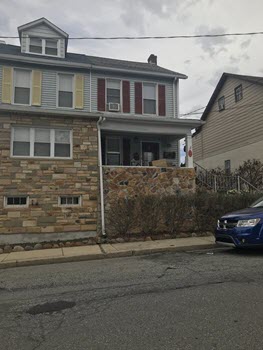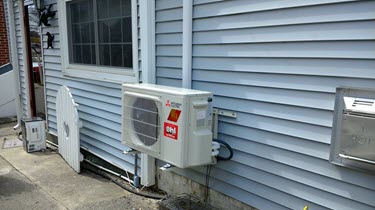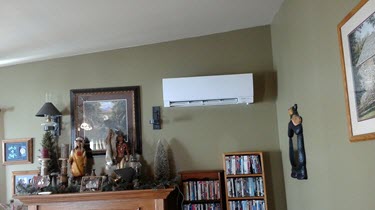Ductless Panels Add Heat And AC In An Addition To A Catasauqua PA Home
 A family in Catasauqua PA loved the new addition to their home. They had just added a new room that they used as a living room. It was another room, one without a TV, where they could relax and enjoy time together.
A family in Catasauqua PA loved the new addition to their home. They had just added a new room that they used as a living room. It was another room, one without a TV, where they could relax and enjoy time together.
However, there was just one problem. Well, two: heating and cooling.
Since the room was a new addition, it wasn’t connecting to the existing HVAC system in the house. There was a propane fireplace in the nearby den, but that didn’t do the trick. The new room didn’t get enough heat to keep it warm in the winter.
Meanwhile, the home’s air conditioning didn’t reach the room, either. Since there were no vents in the addition, it was difficult to connect it. So, many times the area got too warm during the summer months.
Obviously, the family wanted to add heat and air conditioning to their new room. But, adding ductwork to connect to the home’s central system would be very expensive. And, adding window air conditioners and space heaters would cause their electric bills to skyrocket.
Thanks to new technology, however, we were able to give them the strength of a central system with the flexibility of smaller units. And, it wouldn’t be nearly as difficult — or costly — as adding new ductwork.
Problem: A new addition to a two-story home in Catasauqua PA did not get enough heat from a nearby propane fireplace. It also needed air conditioning.
Solution: Installed a Mitsubishi ductless panel in the new room with an outdoor heat pump.
Adding HVAC To A New Addition
 Ductless panels are a great way to add efficient heating and cooling to a new home. It’s less expensive than tapping into an existing system. And, the panels are more powerful than window units and space heaters.
Ductless panels are a great way to add efficient heating and cooling to a new home. It’s less expensive than tapping into an existing system. And, the panels are more powerful than window units and space heaters.
It’s not unusual to pay a thousand dollars or just for an HVAC company to design, build and install new ductwork that connects to the existing system. That’s often a big expense to add on to the already-hefty price tag for construction.
But, for decades that was the best way to add climate control to a new room. Now, ductless provides the same strength at a fraction of the price.
Here’s how it works: An outdoor heat pump generates forced heat or cool air. That air travels through small, flexible plastic tubing.
This part of the system plays a huge role in making it so versatile. The tubing is around two inches thick. As a result, it’s very easy to place anywhere. Our installers can run it behind the walls like electrical wiring.
On the other end is a panel that’s mounted on a wall. The tube connects to the back of the panel, which distributes the treated air. We can place these panels anywhere, and installation takes minutes.
This process makes installing a system like this inexpensive and easy. There’s no need to build new ducts and figure out where to put them. Our installers also don’t have cut out walls or floors to put in vents.
Ductless Panels Offer Zoned Heating And Cooling
 Ductless panels create what’s called zoned heating and cooling. That means each panel is responsible for one room, or zone, in the house. In this case, we only needed to install one panel, since only one area required treatment.
Ductless panels create what’s called zoned heating and cooling. That means each panel is responsible for one room, or zone, in the house. In this case, we only needed to install one panel, since only one area required treatment.
Each panel has its own thermostat. That means they work independently of the others. When the temperature in just that zone needs to change, that panel turns on. Then, it turns back off once the temperature is right.
Zoned HVAC is different from a furnace that serves a whole house or central air conditioning. In those cases, there’s usually one thermostat for the entire home. The system turns on and shuts off according to that reading.
But, other rooms in the house may need more treatment. That leads to uneven climate control. If you’ve ever had bedrooms that are cold in the winter and warm in the summer, that’s probably why.
That’s not a problem with a zoned system, however. Here, each panel maintains its zone. In this way, it’s similar to using window air conditioners. But, there are a few significant differences.
First, the panels don’t need to be taken in and out of the windows each year. And, they don’t require nearly as much maintenance. Next, they are much more efficient, meaning they use much less energy for the same — or better results.
Finally, they’re whisper-quiet. This is very different from the constant roar of a window ac. Unless you are standing right under the panel and are listening for it, you’d never know it’s on.
This is why the panels were a great option for the new addition in this home. The family didn’t need to overdo it by tapping into the central system. Nor did they want to use inefficient window units and space heaters.
Instead, they’re able to control the temperature with one panel in that one zone. And, in the long run, our homeowners spend much less than if they’d gone with the other options.
Saving Money With Ductless HVAC
 Installing ductless panels saves money on energy bills over other options. Since they use less energy than other options, they cost less to run. In houses where people have replaced their old systems with ductless, they notice lower energy bills immediately.
Installing ductless panels saves money on energy bills over other options. Since they use less energy than other options, they cost less to run. In houses where people have replaced their old systems with ductless, they notice lower energy bills immediately.
These savings occur for a few reasons. First is the way the system produces heat or cold air. The outdoor heat pump uses a heat exchange process that barely uses any electricity at all.
In the winter, it draws what little heat there is outside and amplifies it before sending it into the house. When it’s hot out, the heat pump pulls the heat from the home and cools it. This process leaves cool air in the house and pumps in more cold air.
Next is the tubing that transports the treated air. Unlike ductwork, it is sealed tight. No warmed or cool air escaped along the way. That means the system has to produce less to do its job.
Also, the panels do a better job of distributing the air than vents. This way, the area gets to the desired temperature quickly.
After that, the homeowners can use the panels to customize their climate control. That lets them get the treatment they want without using as much energy.
In this case, the home only has one panel. But, the addition still gets some heat from the nearby propane stove. So, it doesn’t need to work nearly as much as it would if it were the only heat source. Since it has a thermostat, it won’t turn on nearly as much as if it were connected to a central system.
Finally, our homeowners can just choose to leave it off if they want. Many people use this option at different times of the day. They’ll still heat their home in the evening, for instance. But, they’ll probably not worry about their new room when they’re sleeping. That’s less energy they’ll use for quite a few hours.
These factors made the Mitsubishi panels an excellent investment for this home. Our homeowners will get the fine-tuned climate control they need in their new addition. But, they won’t pay extra or overdo it.
If you are looking to explore ways to save money on your heating bills or have a problem with your current system, give us a call here at RF Ohl. We have the experience and the know how to make sure you are comfortable in your home, every day of the year, and save money at the same time.
